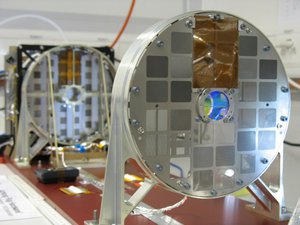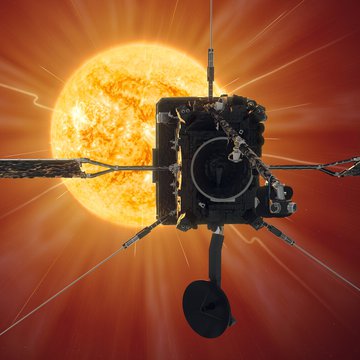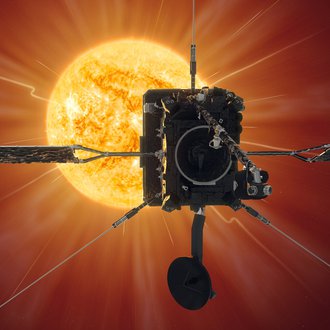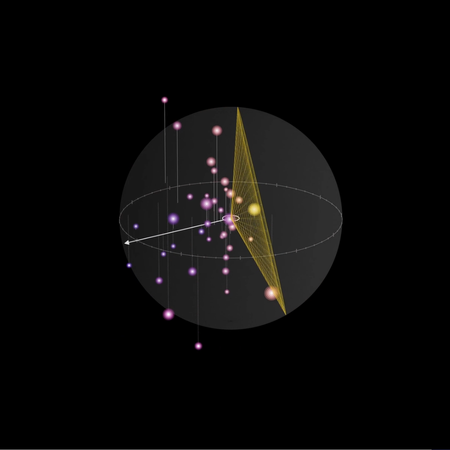Virtual lecture: Babelsberg Starry Night on 17th April 2025
The next Virtual Babelsberg Starry Night of the Leibniz Institute for Astrophysics Potsdam (AIP), will feature two lectures on the topic "Solar Orbiter – X-ray view of the Sun" (in German) by Dr. Alexander Warmuth. The lectures will be broadcast on the YouTube channels “Urknall, Weltall und das Leben” (Big Bang, Universe and Life) and “videowissen” from Thursday, 17 April 2025.
On Thursday from 8 p.m., the two lectures by Dr Alexander Warmuth on ‘Solar Orbiter - X-ray view of the Sun’ from the virtual Babelsberg Starry Nights series will be online. The solar physicist will give an update on ESA's Solar Orbiter mission. Since 2020, this space mission has been orbiting the Sun, analysing our star with its ten different instruments.
The first lecture, which will be broadcast on the “Urknall, Weltall und das Leben” (Big Bang, Universe and Life) channel, focuses on scientific results obtained mainly with the STIX X-ray telescope on board the Solar Orbiter spacecraft. STIX is used to observe the hottest regions and most energetic processes in solar flares. Over the last few years, solar activity has steadily increased, so that researchers have already been able to observe over 70,000 of these eruptions. The research involves combining STIX with other instruments. For example, scientists have produced the first 3D images of solar eruptions in the X-ray range. STIX and other instruments on Solar Orbiter are also used to investigate what is ejected from the Sun, in particular high-energy particles and plasma clouds, and which consequences arise for the Earth and the space weather.

The STIX X-ray telescope before its installation on Solar Orbiter.
Credit: AIP/H. ÖnelIn the second lecture, which will appear at the same time on the “videowissen” YouTube channel, interested parties can take a look behind the technical scenes of the STIX X-ray telescope. Alexander Warmuth addresses various questions: How does an X-ray telescope actually work? How does it produce X-ray images of the Sun, even though the radiation is so energetic that neither lenses nor mirrors can be used in the telescope? What are the requirements for an instrument that comes closer to the Sun than the closest planet Mercury?
Usually on the 3rd Thursday of each month, starting at 8 p.m., the lectures of the Babelsberg Starry Nights become available at
https://www.aip.de/babelsberger-sternennaechte
and via the YouTube channels "Urknall, Weltall und das Leben" (Big Bang, Universe and Life) and "videowissen" and can be viewed afterwards at any time.
The next Virtual Babelsberg Starry Night of the Leibniz Institute for Astrophysics Potsdam (AIP), will feature two lectures on the topic "Solar Orbiter – X-ray view of the Sun" (in German) by Dr. Alexander Warmuth. The lectures will be broadcast on the YouTube channels “Urknall, Weltall und das Leben” (Big Bang, Universe and Life) and “videowissen” from Thursday, 17 April 2025.
On Thursday from 8 p.m., the two lectures by Dr Alexander Warmuth on ‘Solar Orbiter - X-ray view of the Sun’ from the virtual Babelsberg Starry Nights series will be online. The solar physicist will give an update on ESA's Solar Orbiter mission. Since 2020, this space mission has been orbiting the Sun, analysing our star with its ten different instruments.
The first lecture, which will be broadcast on the “Urknall, Weltall und das Leben” (Big Bang, Universe and Life) channel, focuses on scientific results obtained mainly with the STIX X-ray telescope on board the Solar Orbiter spacecraft. STIX is used to observe the hottest regions and most energetic processes in solar flares. Over the last few years, solar activity has steadily increased, so that researchers have already been able to observe over 70,000 of these eruptions. The research involves combining STIX with other instruments. For example, scientists have produced the first 3D images of solar eruptions in the X-ray range. STIX and other instruments on Solar Orbiter are also used to investigate what is ejected from the Sun, in particular high-energy particles and plasma clouds, and which consequences arise for the Earth and the space weather.

The STIX X-ray telescope before its installation on Solar Orbiter.
Credit: AIP/H. ÖnelIn the second lecture, which will appear at the same time on the “videowissen” YouTube channel, interested parties can take a look behind the technical scenes of the STIX X-ray telescope. Alexander Warmuth addresses various questions: How does an X-ray telescope actually work? How does it produce X-ray images of the Sun, even though the radiation is so energetic that neither lenses nor mirrors can be used in the telescope? What are the requirements for an instrument that comes closer to the Sun than the closest planet Mercury?
Usually on the 3rd Thursday of each month, starting at 8 p.m., the lectures of the Babelsberg Starry Nights become available at
https://www.aip.de/babelsberger-sternennaechte
and via the YouTube channels "Urknall, Weltall und das Leben" (Big Bang, Universe and Life) and "videowissen" and can be viewed afterwards at any time.
Images
Artist’s impression of the ESA spacecraft Solar Orbit in front of the Sun.
Big screen size [1000 x 562, 60 KB]
Original size [1920 x 1080, 190 KB]
The STIX X-ray telescope before its installation on Solar Orbiter.






